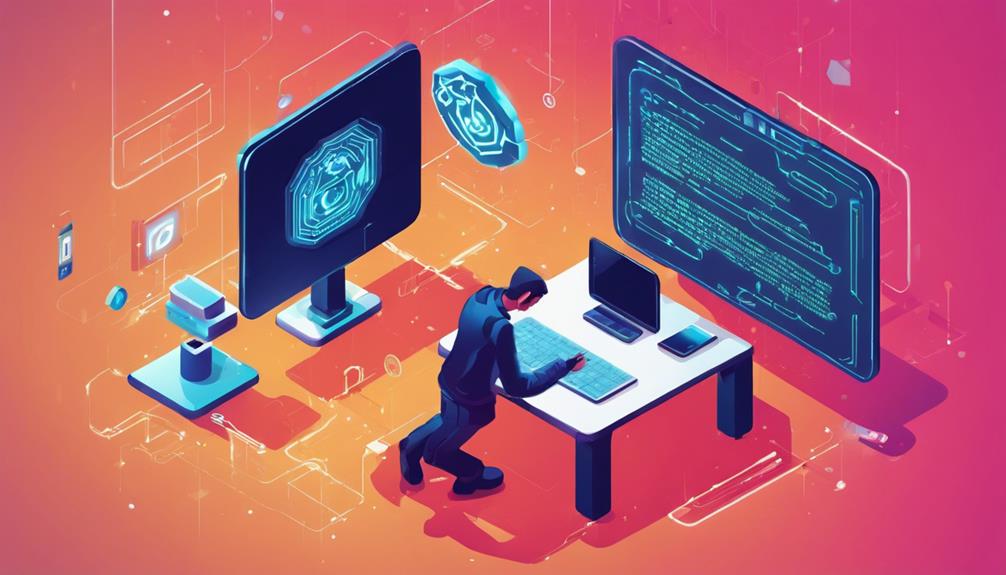Two-Factor Authentication (2FA) adds an essential layer of security to your online accounts. By requiring a second verification step, it markedly reduces the risk of unauthorized access, especially if your password’s compromised. You can choose biometric methods like fingerprints or facial recognition, or use security tokens that generate one-time codes. Implementing 2FA is straightforward and can prevent future security issues. Stay tuned to discover more ways you can enhance your digital protection.
Key Takeaways
- Two-Factor Authentication (2FA) adds an essential extra layer of security, protecting accounts even if passwords are compromised.
- It employs various methods, including biometric verification and security tokens, enhancing defense against cyber threats.
- 2FA is widely supported across major platforms, making it accessible for users to implement.
- The setup process for 2FA is user-friendly and typically takes only a few moments to complete.
- With the rise of data breaches, 2FA is now a necessity for safeguarding sensitive information and preventing unauthorized access.

Have you ever wondered how to enhance your online security? If you haven’t yet adopted two-factor authentication (2FA), you’re missing out on a straightforward way to protect yourself from cyber threats. This extra layer of security helps guarantee that even if someone manages to steal your password, they won’t easily gain access to your accounts. 2FA requires you to provide two forms of verification before you can log in, making it much harder for unauthorized users to compromise your information.
One of the most effective methods of achieving this is through biometric verification. This technique utilizes unique physical traits, such as fingerprints or facial recognition, to confirm your identity. Imagine logging into your bank account not just with a password but by quickly scanning your fingerprint. It’s not only convenient but adds a notable security boost. Biometric verification is nearly impossible to replicate, making it a solid choice for safeguarding sensitive information.
Another option involves the use of security tokens. These are physical devices or applications that generate a one-time code, usually sent to your smartphone or email. When you try to access your account, you’ll need to input this code alongside your password. Since the code changes every few seconds, even if someone manages to capture your password, they won’t have the additional token required for access. This layered approach makes it far more difficult for cybercriminals to breach your accounts.
Implementing two-factor authentication is often as simple as enabling a setting on your account. Most major platforms offer this feature, and the process is typically user-friendly. You’ll receive prompts that guide you through linking your biometric verification method or security token to your account. Taking just a few moments to complete this setup can save you from potential headaches down the line.
In today’s digital age, where data breaches are becoming increasingly common, you simply can’t afford to ignore your online security. Two-factor authentication isn’t just an option; it’s a necessity. By incorporating both biometric verification and security tokens into your login process, you’re greatly reducing the risk of unauthorized access. Tights are essential for various activities and can also be a part of your personal security measures when using online services. So, don’t wait any longer. Take the steps to secure your online presence today. Your future self will thank you for it!
Frequently Asked Questions
What Types of Devices Can I Use for Two-Factor Authentication?
You can use various devices for two-factor authentication. Hardware tokens, like key fobs or smart cards, generate unique codes for secure access. Biometric devices, such as fingerprint scanners or facial recognition systems, provide another layer of verification by using your physical traits. Many smartphones also enable two-factor authentication through apps or built-in features. So, whether you prefer hardware or biometric solutions, you’ve got plenty of options to enhance your security.
Can I Bypass Two-Factor Authentication if I Forget My Password?
You can’t simply slip past two-factor authentication if you forget your password. However, many services offer security bypass methods through recovery options, like backup codes or email links. Start by checking if you’ve set up any recovery contacts; they can help you regain access. Staying secure is essential, so make sure to update your recovery options regularly. Don’t ignore these safeguards—they’re designed to keep your accounts safe and sound!
Is Two-Factor Authentication Available for All Online Accounts?
Yes, two-factor authentication is available for many online accounts, but not all of them. You should check your account settings to see if it’s an option. Implementing this feature can considerably reduce security risks and address privacy concerns, as it adds an extra layer of protection. Always enable it when possible to safeguard your personal information from potential threats and unauthorized access. It’s a simple step towards better online security.
How Does Two-Factor Authentication Impact Account Recovery?
Two-factor authentication can feel like a safety net for your account recovery. When you try to regain access, backup codes become your lifeline. If you’ve lost access to your primary method, those codes allow you to verify your identity and restore account access. Without them, the process might become a frustrating maze. So, keeping your backup codes secure is essential, ensuring you can navigate any bumps in the road smoothly.
Are There Any Costs Associated With Setting up Two-Factor Authentication?
Setting up two-factor authentication usually doesn’t involve direct costs, as most services offer it for free. However, there might be some cost implications if you choose premium authentication apps or hardware tokens. It’s a minimal financial investment compared to the potential losses from a security breach. Ultimately, the peace of mind it provides can outweigh any minor expenses you might incur while enhancing your account’s security.
Conclusion
In today’s digital world, two-factor authentication is like putting a deadbolt on your front door—it’s an indispensable extra layer of security that keeps your personal information safe from prying eyes. By enabling it, you’re not just relying on a password; you’re adding a vital barrier against cyber threats. So, take a moment to activate this feature and protect your accounts. It’s a simple step that can make a world of difference in safeguarding your digital life.








